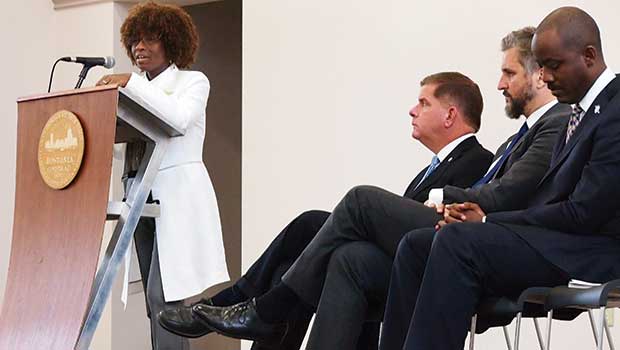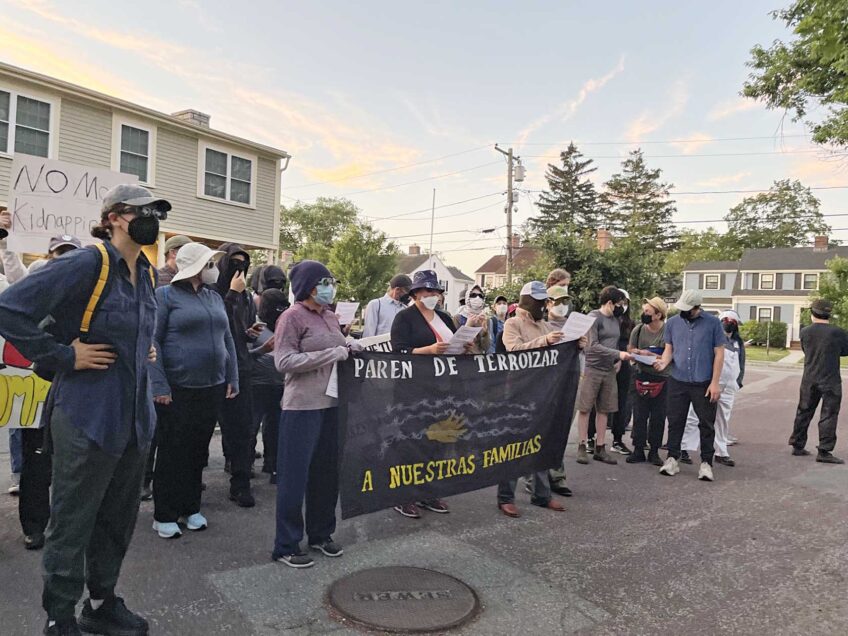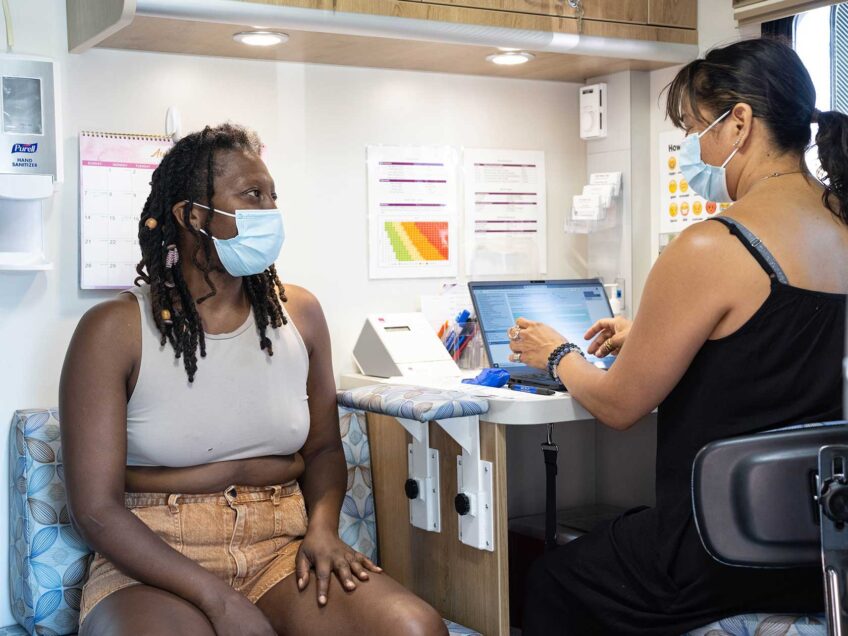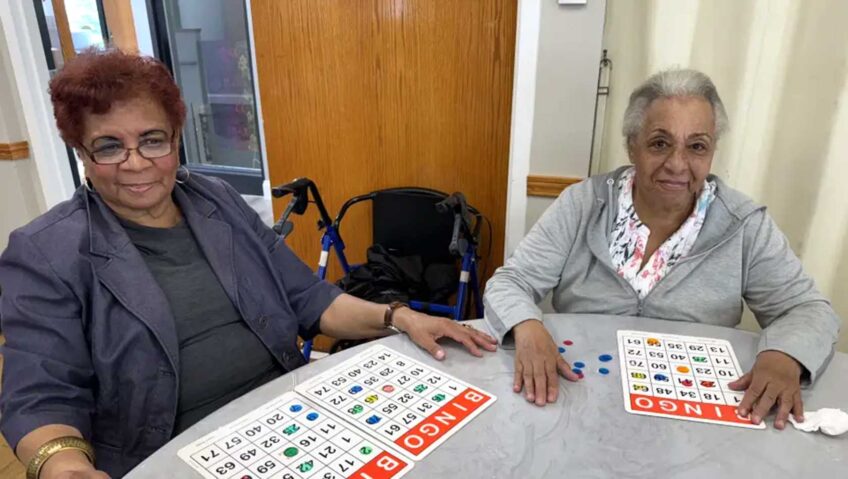City’s new Resilient Boston plan aims to fix racial inequities
Zeroes in on housing, education, jobs, transit

Boston seeks to confront its past with an ambitious new plan that casts light on persistent and systemic racial inequities. Mayor Martin Walsh’s administration released its “Resilient Boston” plan in Grove Hall last Thursday, the fruit of a nearly two-year information gathering and thinking process. The document explores how decades of policies have created racial gaps in wealth and health, with a particular focus on gaps in access to housing, education, jobs, transit and other stability factors. The thrust of the report is that the city promises to roll out policies and planning with a conscious eye toward not just avoiding the expansion of such gaps, but actively closing them.
“It is not by accident” that inequities cut along racial lines, said Atyia Martin, the city’s chief resilience officer. The report notes a history of racially disparate policies and practices nationally and locally. “Racism is something that was created and is something that can be eradicated by us,” Martin said.
On the Web
Boston department of Resilience and Racial Equity: www.Boston.gov/Resilience
Rahsaan Hall, director of the Racial Justice Program of the ACLU of Massachusetts, told the Banner in a phone interview that the report’s strengths include intentionally applying a racial equity lens throughout every planning piece and acknowledging the city’s troubled racial history as well as how today’s structural inequities derive from that past.
However, Hall added, some current issues are missing — such as the underrepresentation of children of color in Boston’s exam schools, which has been a topic of interest for the ACLU-MA and other local civil rights groups. He also noted that with most Resilient Boston initiatives still in planning or development stages, it leaves questions on how final implementation will be ensured. Affordable housing is a pressing need right now, and steps that are still in progress may not be sufficiently timely, he said.
“This is a very aspirational document,” Hall said. “There was a lack of clarity on how this document becomes institutionalized and executed at every level of city government and how this is leveraged within the private sector.”
Walsh’s strongest mayoral challenger, City Councilor Tito Jackson, jumped on the report, noting its timeliness in an election year and charging that prior Walsh administration actions belie the professed commitment to equity. Jackson cited the persistent white domination of police and fire ranks, as well as the passage of this year’s school budget over objections by the school committee’s Opportunity and Achievement Gap Task Force.
“For the past three and a half years, Mayor Walsh has shown us he is simply not serious about dealing with issues of racial equity in Boston,” Jackson said in a statement.
The Resilient Boston plan is part of the city’s participation in the worldwide 100 Resilient Cities initiative. It lays out visions, goals and actions to build resilience in Boston by ensuring the most vulnerable residents are better able to cope with climate change and other threats to the wellbeing of the city. Proposals aim to break down social silos across race in Boston and prompt companies and residents to examine their own practices in order to have a cohesive and equitable city. Other focus areas include engaging residents better in local government and improving diversity in city hiring and promotion; increasing access to economic opportunity; and preparing neighborhoods against crises such as climate change and instances of violence.
Included in the resiliency plan are some concrete ready-to-go initiatives, along many areas where actions remain in the early stage of solution generation.
Economics
Initiatives to bolster economic outcomes of vulnerable populations include improving job access and capabilities of small businesses. Between 2000 and 2014, incomes in Roxbury dropped by nearly 30 percent, compared to a citywide average drop of about 8 percent, according to the report.
An Economic Mobility Lab would be created to analyze programs and policies and pilot targeted interventions, especially for niche populations such as incarcerated individuals, low-income youth and single mothers. A Business Capital and Finance Unit launched in March 2017 distributes microloans and flexible gap financing to immigrant-, women- and minority-owned businesses, as well as industrial small businesses and restaurants, and the Office of Financial Empowerment, formalized in 2014, assists small businesses. One proposal would alter zoning so that predominately minority communities have fewer of the zoning rules that make it hard to have certain types of small businesses.
A partnership with the Greater Boston Chamber of Commerce is intended to help provide private firms with guidance on examining their own practices, advancing equity in the city and holding intracompany conversations on such topics.
Actions outlined in the report for increasing the number and salaries of city workers of color include developing a targeted outreach strategy aimed at securing more job applicants of color and re-establishing the mayor’s Diversity Taskforce. The report claims that 44 percent of new hires since Walsh took office have been people of color, and states that black, Latino and Asian city employees are underrepresented among city employees earning more than $60,000 a year.
While the report says that in 2015, the Boston Police Department’s share of black and Latino recruits reflected citywide populations, the city could not provide the Banner with information on how many of these recruits actually went on to serve on the police force.
Speaking to the Banner at the report unveiling, Martin said that given the challenge the state civil service policy presents to hiring non-white candidates, the city must identify plans to diversity police and fire within those constraints — such as institution of a fire cadet program — while also lobbying to the state for changes.
Education and digital
According to the report, “many studies show that a Bostonian’s race dictates his or her access to quality affordable housing, digital technology, and educational opportunities, all of which are foundational building blocks for intergenerational wealth building.” Some efforts to address this aim to expand public Wi-Fi access and improve educational outcomes. Proposals include institution of restorative justice practices in schools to help combat racially disparate discipline rates and promotion of universal access to high-quality pre-kindergarten.
Housing and transit
Initiatives to improve housing access and retention include continuing efforts to build more housing units and expand supports to those facing eviction. Measures include promotion of the Jim Brooks Community Stabilization Act and state income tax credits for landlords who offer non-subsidized units for below-market rent.
Otis Rolley, 100 Resilient Cities regional director for North America, reflected at the report unveiling that crises such as the MBTA snow shutdown have a disparately negative impact on some communities. Efforts to improve transit equity include the Fairmount/Indigo line extension targeted for 2021, and upgrades to the line to bring faster transit. The extension’s completion is expected to bring a public transit option within walking distance to about 12,000 additional people in communities especially reliant on public transit and with low access to job centers.
Smaller level fixes include switching to regular sidewalk inspection, instead of relying on residents calling in to report issues as the cue to make repairs.
Climate and trauma
Preparation for climate change and extreme weather includes setting up alternative energy generation sources in case the main energy grid gets knocked out. A microgrid pilot project is planned for Lower Roxbury.
To better respond to violent incidents and other stressors, the report calls for more Boston Public Health Center neighborhood trauma teams and training of local community partners to provide mental health services.
The report’s scope is sweeping, and Martin told the Banner that had there been more time, she would have liked to dig deeper into addressing mental health needs. This would include addressing a tendency of responses to focus on treating an individual patient’s mental health symptoms, rather than also looking for and tackling the societal-based root causes.






